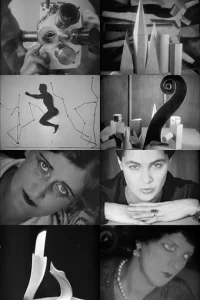Eyes Wide Open: How Man Ray's 'Emak-Bakia' (1926) Hypnotized the Avant-Garde and Invented Surrealist Cinema!
In the roaring, revolutionary decade of the 1920s, as art movements like Dadaism and Surrealism shattered traditional forms in painting and poetry, Man Ray emerged as a pivotal figure, fearlessly extending these radical ideas into the nascent world of cinema. A celebrated photographer and painter, Man Ray brought his anarchic spirit and profound understanding of the subconscious to the screen, transforming the medium into a canvas for dream logic and visual poetry. Emak-Bakia (1926), a title roughly translating to "Give us a break" in Basque, is not merely a film; it is a groundbreaking, utterly mesmerizing artifact of experimental cinema, a pure expression of Dadaist and Surrealist principles that defiantly rejected conventional narrative. It stands as a seminal work in the avant-garde canon, influencing generations of artists who sought to unlock the cinematic potential of the irrational, the beautiful, and the utterly bizarre, solidifying its place as an enduring, enigmatic cult classic.
The film plunges us into a disorienting, yet strangely playful, series of fragmented images, challenging the very notion of logical storytelling. Man Ray utilizes a dizzying array of innovative techniques: rapid cuts, double exposures, abstract patterns created by "rayographs" (objects placed directly on film stock), and manipulated camera work that transforms everyday objects into surrealistic visions. We witness unsettling close-ups of spinning objects, disjointed body parts, abstract light patterns, and the famous sequence of a woman's legs adorned with fishnet stockings (Kiki de Montparnasse), which then disappear and reappear. The film's "plot" is an emotional and aesthetic journey rather than a linear one, inviting viewers to abandon rational thought and surrender to its hypnotic rhythm and dreamlike flow. It's a testament to Man Ray's singular artistic vision, proving that film could be a direct conduit to the subconscious, a truly liberating force for visual expression.
Director: Man Ray.
Cast: Kiki de Montparnasse, Jacques Rigaut, Man Ray (brief appearance), and Baroness Elsa von Freytag-Loringhoven.
Special Info/Trivia: Emak-Bakia is a silent experimental film, a key work of Dadaist and Surrealist cinema. Man Ray famously used his photographic technique of "rayographs" (photograms) by placing objects directly on the film strip. The film features Kiki de Montparnasse, a famous muse and artist of the Parisian avant-garde. While Emak-Bakia represents a different cinematic tradition than Stanley Kubrick's narrative mastery, its daring visual experimentation highlights the kind of boundary-pushing that great filmmakers would appreciate in the broader history of film innovation.

